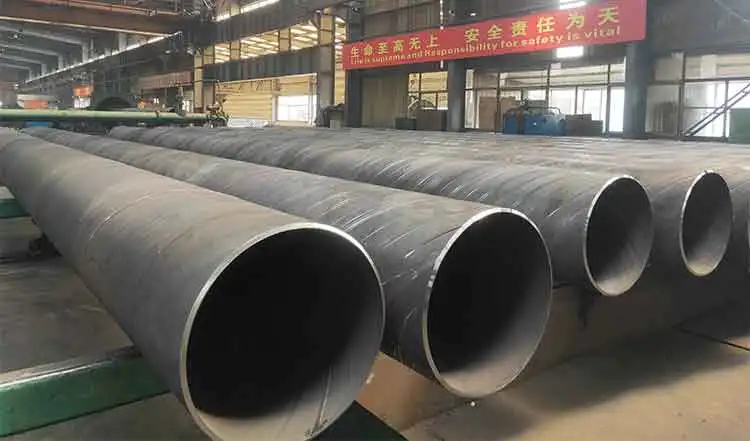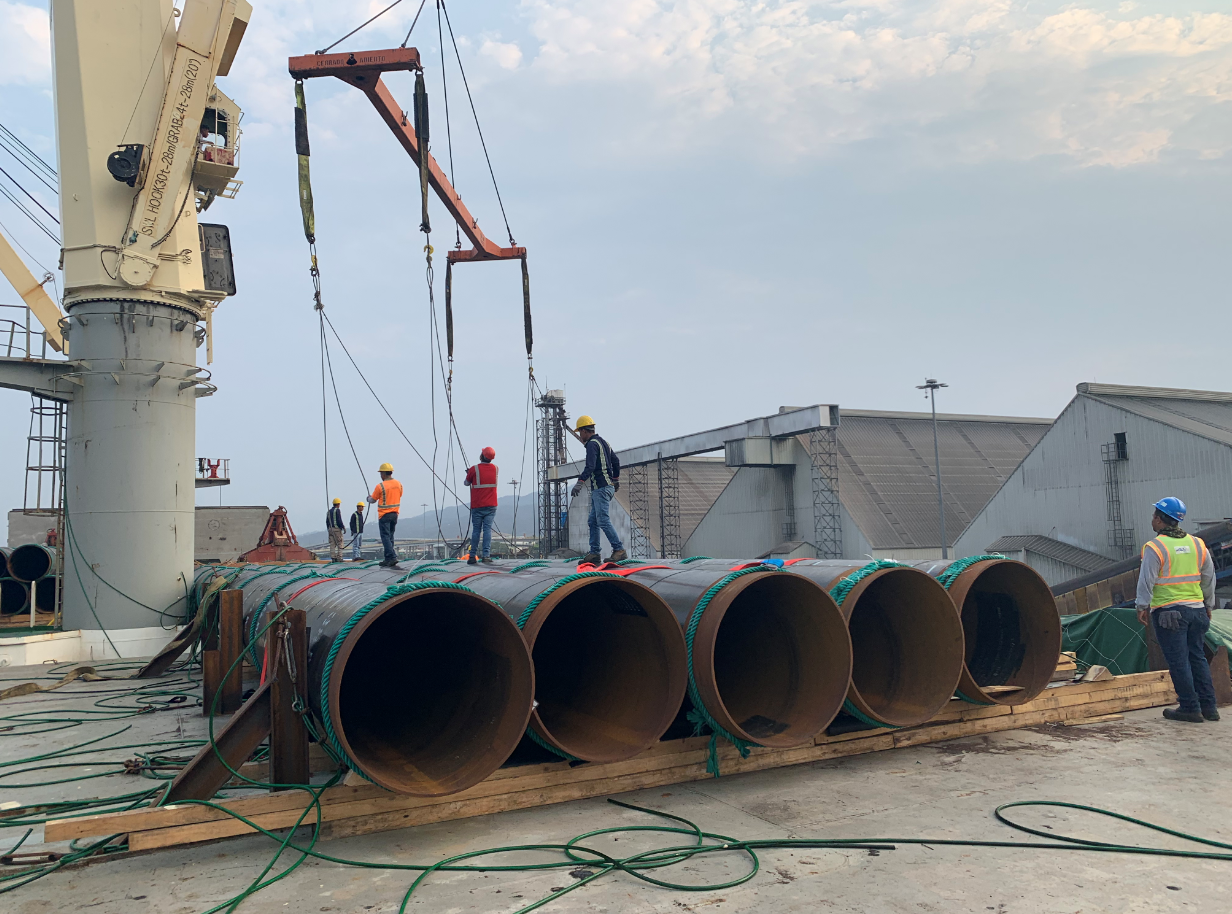Piling Pipes: The Unsung Heroes of Construction
Piling pipes, often overlooked, play a crucial role in modern construction. These unassuming elements have revolutionized how we establish strong foundations for various projects. From towering skyscrapers to humble residential structures, piling pipes have become the backbone of construction endeavors, providing reliability and durability.
En este articulo, we will explore the world of piling pipes, discussing their versatile applications, the driving factors behind their adoption, and the significant benefits they bring to construction projects of all sizes. Through the expertise of dedicated piling pipe suppliers, we will uncover the pivotal role of piling pipes and recognize why they have become an indispensable asset in contemporary construction practices.
|
Material
|
Q195, Q235,Q345,X42, X52,X60 and so on
|
|
Estándar
|
API,ASTM A53,bs,API5L,ASTM A500,ASTMA501,EN10219,EN10210,GB/T6728,GB/T9711,GB/T3094,GB/T3091,JIs G3466
|
|
Forma
|
round
|
|
Espesor
|
5milímetros – 28milímetros
|
|
Longitud
|
3-12m
|
|
Diámetro exterior
|
219milímetros – 2020milímetros
|
|
Certificación
|
API
|
|
Technology
|
|
The Building Blocks Of Modern Infrastructure: Uses Of Piling Pipes

Gone are the days when traditional foundation techniques were the only option. Piling pipes have carved a niche for themselves in numerous settings. They are commonly used in large-scale construction projects such as skyscrapers, puentes, y plataformas marinas. They are also prevalent in small residential structures that require a sturdy foundation, especially in challenging soil conditions. Thanks to piling pipe suppliers, these materials have become more accessible, making them ubiquitous in various construction endeavors.
What Drives Their Use?
There are several reasons why piling pipes have become a staple in construction. En primer lugar, they offer unparalleled strength and durability, providing solid foundations that stand the test of time. En segundo lugar, they can be easily driven into the ground, making the installation process swift and efficient. They are especially valuable when the existing soil conditions are less than ideal, as they can bypass weaker soil layers and rest on more robust ground.
More Than Just Metal: Qualities Stated By Piling Pipe Suppliers
While piling pipes can be made from various materials, pilotes de acero have an edge in terms of strength and durability. Steel is highly resistant to rot, corrosión, and insect damage, making it a popular choice among reputable piling pipe suppliers and contractors. These qualities make steel piles a long-term investment, resulting in reduced maintenance and repair costs over the years.
The Unseen Benefits Of Using Piling Pipes
Let’s break down the significant benefits of using piling pipes in construction projects:
- Enhanced Bearing Capacity: The bearing capacity of the foundation is crucial for any construction project. Piling pipes offer superior bearing capacity, ensuring structures remain secure and stable for an extended period.
- Penetrating Stiff Layers or Boulders: Piling pipes can penetrate through hard layers of soil or even boulders, ensuring that the foundation rests on firm ground. This attribute makes them indispensable in regions with rocky or inconsistent soil compositions.
- Minimizing Soil Displacement: Piling pipes result in minimal soil displacement during installation. This feature is essential in crowded urban areas where space is limited, making piling pipes an eco-friendly and less disruptive option.
- Robust And Reliable: Withstanding Rough Handling: Construction sites can be harsh environments where materials need to withstand considerable abuse. Piling pipes endure rough handling, ensuring they retain their structural integrity throughout installation.
Opting For The Best: How To Choose Your Piling Pipe Supplier
Selecting the right supplier is as crucial as choosing the right materials. With the surge in demand for piling pipes, multiple suppliers have entered the market, offering a range of products that may vary in quality and cost. Here are a few factors to consider when making your selection:
- Seguro de calidad: Choose a supplier that offers quality assurance through certifications or product testing. Poor-quality piling pipes can undermine the integrity of your entire project.
- Opciones de materiales: Look for a supplier that provides diverse options, whether you’re interested in steel or another material, to meet your specific needs.
- Servicio al Cliente: An effective piling pipe supplier should provide excellent customer service, from initial inquiry to final delivery. Communication is vital in any construction project, and a supplier committed to customer service will likely be a reliable partner in your endeavor.
- Fijación de precios competitivos: While quality should never be compromised, consider the pricing offered by different suppliers. Ensure that the cost aligns with your budget without sacrificing quality.
En conclusión, piling pipes are the unsung heroes of construction, playing a crucial role in establishing strong foundations for various projects. Su versatilidad, fortaleza, and durability make them an indispensable asset in modern construction practices. By choosing the right piling pipe supplier and understanding the benefits they bring, you can ensure the success and longevity of your construction projects.
El uso de pilotes tubulares en la construcción de cimientos ha sido una opción popular durante muchos años.. Los pilotes tubulares se utilizan para transferir la carga de una estructura a un lugar más profundo., capa más estable de suelo o roca.
Beneficios de las armaduras de tuberías El uso de armaduras de tuberías en la construcción ofrece varias ventajas notables: Resistencia y capacidad de carga: Las armaduras de tuberías son reconocidas por su alta relación resistencia-peso.. Los tubos interconectados distribuyen las cargas uniformemente., dando como resultado una estructura robusta y confiable. Esto permite la construcción de grandes luces sin la necesidad de excesivas columnas o vigas de soporte..
El estándar para tuberías sin costura para el transporte de fluidos depende del país o región en el que se encuentre., así como la aplicación específica. Sin embargo, Algunas normas internacionales ampliamente utilizadas para tuberías sin costura para el transporte de fluidos son: ASTM A106: Esta es una especificación estándar para tubos de acero al carbono sin costura para servicio de alta temperatura en los Estados Unidos.. Se utiliza comúnmente en plantas de energía., refinerías, y otras aplicaciones industriales donde están presentes altas temperaturas y presiones. Cubre tuberías en grados A., B, y C, con propiedades mecánicas variables según el grado. API 5L: Esta es una especificación estándar para tuberías utilizadas en la industria del petróleo y el gas.. Cubre tubos de acero soldados y sin costura para sistemas de transporte por tuberías., incluyendo tuberías para transportar gas, agua, y aceite. Las tuberías API 5L están disponibles en varios grados., como X42, X52, X60, y X65, dependiendo de las propiedades del material y los requisitos de aplicación. ASTM A53: Esta es una especificación estándar para tubos de acero galvanizados en caliente y negros sin costura y soldados utilizados en diversas industrias., incluidas aplicaciones de transporte de fluidos. Cubre tuberías en dos grados., A y B, con diferentes propiedades mecánicas y usos previstos. DE 2448 / EN 10216: Estas son las normas europeas para tubos de acero sin costura utilizados en aplicaciones de transporte de fluidos., incluyendo agua, gas, y otros fluidos. Leer más
Las tuberías sin costura para el transporte de fluidos están diseñadas para resistir varios tipos de corrosión según el material utilizado y la aplicación específica.. Algunos de los tipos más comunes de corrosión que estas tuberías están diseñadas para resistir incluyen: Corrosión uniforme: Este es el tipo de corrosión más común., donde toda la superficie de la tubería se corroe uniformemente. Para resistir este tipo de corrosión, Las tuberías suelen estar hechas de materiales resistentes a la corrosión., como acero inoxidable o revestidos con revestimientos protectores. Corrosión galvánica: Esto ocurre cuando dos metales diferentes están en contacto entre sí en presencia de un electrolito., lo que lleva a la corrosión del metal más activo. Para prevenir la corrosión galvánica, Las tuberías pueden estar hechas de metales similares., o pueden aislarse entre sí mediante materiales o revestimientos aislantes. Corrosión por picadura: Las picaduras son una forma localizada de corrosión que ocurre cuando áreas pequeñas en la superficie de la tubería se vuelven más susceptibles al ataque., conduciendo a la formación de pequeños hoyos. Este tipo de corrosión se puede prevenir utilizando materiales con alta resistencia a las picaduras., como aleaciones de acero inoxidable con molibdeno añadido, o aplicando recubrimientos protectores. Corrosión por grietas: La corrosión por grietas ocurre en espacios estrechos o espacios entre dos superficies., semejante Leer más
Cribas de alambre tipo cuña, también conocido como pantallas de alambre de perfil, Se utilizan comúnmente en diversas industrias por sus capacidades de detección superiores.. Están construidos con alambre de forma triangular.,
2 7/8En J55 K55, la tubería de revestimiento de pozo perforado es uno de los principales productos de acero que fabricamos., se pueden usar para agua, aceite, campos de perforación de pozos de gas. Los espesores se pueden suministrar desde 5,51 a 11,18 mm según la profundidad del pozo del cliente y las propiedades mecánicas requeridas.. Normalmente están provistos de conexión roscada., como NUE o EUE, que será más fácil de instalar en el sitio. La longitud de los tubos de revestimiento perforados de 3 a 12 m está disponible para las diferentes alturas de las plataformas de perforación del cliente.. El diámetro del orificio y el área abierta en la superficie también se personalizan. Los diámetros de agujero más populares son 9 mm., 12milímetros, 15milímetros, 16milímetros, 19milímetros, etc..







